
Trekking/Bivouac in the Chartreuse: A Night Above the Clouds (With My Four-Legged Partner — My Dog Lola🐕)
Share
A 25-kilometer, two-day journey through the mountains — testing gear, pushing limits, and sharing the adventure with the best hiking 4-Legged companion and my tracking partner.
Summit by sunset, sleep under stars, explore the ridgeline at dawn, descend in daylight. And I wasn’t doing it alone. My dog and I had 25 kilometers ahead of us, 1,600 meters of climbing, and one night at altitude to test every piece of gear we carried.
Not a member, check here: https://medium.com/@simonatomarcelo/trekking-bivouac-in-the-chartreuse-a-night-above-the-clouds-with-my-four-legged-partner-my-dog-faa12bbc91e3?source=friends_link&sk=dffdb0a1ddb146c240d92b2495377836
👉 Want to a good kit to start your trekking adventure: Here it is
Or a better waterproof one for big players ;) -> https://therightpace.store/products/camping-tent-for-1-or-2-or-3-persons-with-3000mm-or-4000mm-waterproof
https://therightpace.store/products/90l-waterproof-hiking-camping-backpack
Day One: The Ascent — 1,267 Meters of Vertical Reality
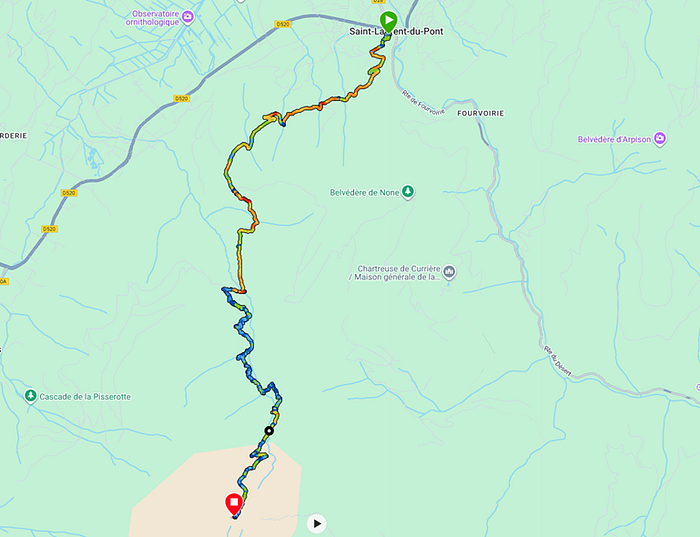
Starting from the city of Saint-Laurent-du-Pont around mid-afternoon (12h18p.m), the trail immediately made its intentions clear. Over the next 2 hours and 41 minutes of actual movement, spread across nearly 5 hours of elapsed time, we would climb 1,267 meters — some stops to see the views, look for some animals, recovering and really appreciating this trekking.
My tracking partner was with a 50L bag, and me with a 90L, and it carried its weight immediately: My 90L hiking backpack, loaded with tent, sleeping bag, headlamp, cooking gear, two days of food, and extra water for me and my dog, transformed this from a hike into a genuine mountain expedition. Every kilogram matter when you’re gaining this much elevation, and having all with you is very important, so this bag is for sure one of the best investments I made.
Want to check this bag, here it is: https://therightpace.store/products/90l-waterproof-hiking-camping-backpack?variant=57164438733181

The temperature hovered around 26°C, warm for mountain hiking, occasionally spiking to 31°C in exposed sections. My heart rate told the story my legs were living: an average of 133 bpm, with peaks reaching 176 bpm on the steeper pitches. The trail didn’t ask permission; it simply went up, and my dog — trotting ahead, circling back, sniffing every interesting rock — was covering easily double my distance.
Gear check #1: My headlamp stayed accessible in the pack’s top pocket — essential when you’re planning to arrive at camp near dusk. The lightweight microfiber towel compressed to nothing but would prove invaluable after the sweat-soaked ascent.
Want to check this lamp: https://therightpace.store/products/powerful-led-headlamp-telescopic-zoomable-head-torch-outdoor-waterproof-rechargeable-fishing-camping-portable-headlight
The data from my watch showed 17,860 steps. My average cadence of 56 steps per minute reflected the reality of steep mountain terrain — this wasn’t trail running; this was methodical, rhythmic climbing. The kind where you find your breath, match it to your stride, and settle into what mountain folk call “the alpine shuffle.”
My four-legged companion maintained his own pace, occasionally waiting on switchbacks with a look that clearly said, “What’s taking you so long?” Dogs don’t carry watches, but if they did, his cardio data would have been impressive.
Arrival: Altitude 1,684 Meters — Camp Setup
By the time we reached the bivouac site, the light was beginning its slow shift toward gold. At 1,684 meters, you’re high enough that the valley below becomes abstract houses shrink to dots, roads become thin lines, and the landscape transforms into a topographic map made real.
This is where gear proves its worth. Setting up camp at altitude has its own rhythm. Every movement is deliberate. You’re tired, but there’s work to do:
- Tent deployment: A lightweight 2-person tent that sets up easily. At altitude, when temperatures are dropping and light is fading, speed matters. No complicated pole systems. Want to checkout a good option of tent -> https://therightpace.store/products/tente-de-camping-pour-2-personnes-tente-dome-avec-toit-amovible-porte-double-couches-2-fenetres-en-maille-sac-de-transport-216x156x116cm-vert
- Or a better waterproof one for big players ;) - Not used on this trekking, but an amazing option for snow ground floors or rainy ones> https://therightpace.store/products/camping-tent-for-1-or-2-or-3-persons-with-3000mm-or-4000mm-waterproof
- Sleeping system organization: My dog immediately claimed his spot inside the tent vestibule, while I arranged my sleeping bag and pad.
- Water management: At 1,684 meters, water is your most critical resource. I’d carried enough up for both of us, rationing carefully.
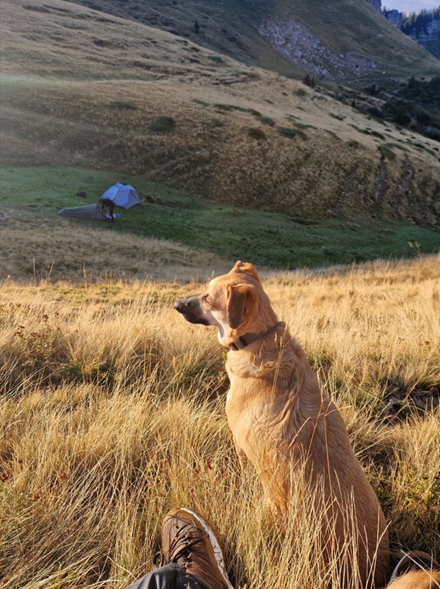
The temperature had dropped from the day’s high of 31°C to a more comfortable range, and I knew it would plunge further after dark. The towel I’d packed — lightweight, fast-drying — helped me clean up before settling in for the night.
The Night: Why We Bivouac
This is why you bivouac. Not for the hike up — though that has its own rewards — but for what happens when the sun drops below the horizon and you’re still up there. The valley fills with shadow. Towns begin to glow. The temperature drops toward the minimum of 22°C, cool enough to appreciate a sleeping bag but not cold enough to be miserable.
The headlamp stayed within reach — middle-of-the-night necessities are easier with proper lighting — and I’d positioned my pack as a windbreak. Small decisions like this compound into comfort. Want to check this lamp: https://therightpace.store/products/powerful-led-headlamp-telescopic-zoomable-head-torch-outdoor-waterproof-rechargeable-fishing-camping-portable-headlight

Day Two, Part One: Dawn on La Sure — The Ridge Walk (2.96 km, 319m ascent)
The headlamp clicked on at first light — around 6:30 AM — illuminating the tent interior as I prepared for the day’s first objective. We weren’t descending yet. First, we had to reach La Sure, the highest point of this expedition at 1,899 meters.
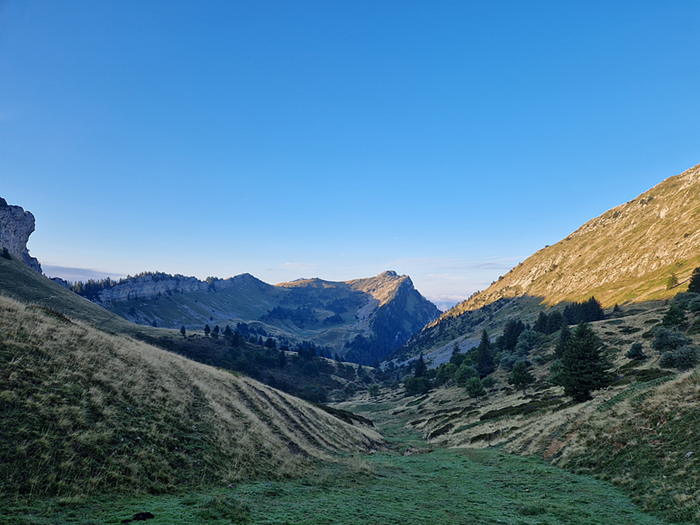
To avoid doing the last part of the ascension with all equipment, we decided to keep all there and take when we get back. Smart decision.
This 3-kilometer section was technical: The trail climbed another 319 meters from our bivouac site, following exposed ridgelines where the Chartreuse shows its full character. The pace was slow — 46:49 per kilometer on average — because this wasn’t about speed. It was about navigating rocky terrain, taking in the 360-degree views, and being present at nearly 1,900 meters elevation.
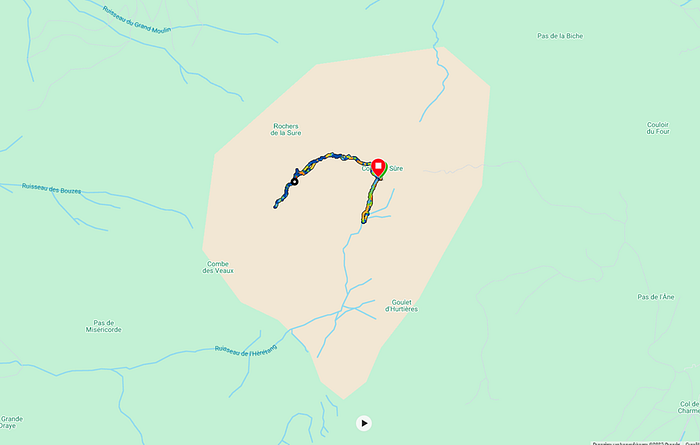
My dog bounded ahead with the effortless energy dogs somehow maintain at altitude. My heart rate averaged 114 bpm over the 2 hours and 18 minutes, peaking at 173 bpm on the steepest sections. The morning temperature ranged from 22°C to 31°C as the sun gained strength.
We covered 5,968 steps through terrain that alternated between limestone slabs, alpine meadows, and narrow ridge paths. The cadence data — averaging just 32 steps per minute — tells the story of technical ground where every foot placement requires attention.
At the summit, the Chartreuse revealed itself fully:

Day Two, Part Two: The Long Descent (9.66 km, 1,282m descent)
Once we descent time to get everything packet to leave.
What goes up must come down, and in the mountains, going down is often harder than going up. We had 9.66 kilometers ahead of us and 1,282 meters of elevation to surrender back to gravity.
The descent was where gear durability mattered most. My knees absorbed continuous impact for 3 hours and 20 minutes. The pack — still loaded with camping gear, now including a collapsed tent, used towel, and empty water containers — rode on my hips and shoulders through thousands of downhill steps (15,886 total).
My dog, as always, made it look easy, trotting ahead down switchbacks, occasionally stopping to wait for the slow human lumbering behind.
The data tells a story of sustained effort: 108 bpm average heart rate, 119 minutes at moderate intensity, temperatures climbing back to 28°C as we dropped elevation. My pace improved to 20:44 per kilometer — gravity’s gift after yesterday’s battle against it — but downhill requires its own kind of respect. The cadence picked up to 69 steps per minute, a faster rhythm but one punctuated by careful foot placement on rocky, root-crossed trail.
Gear performance notes :
- Hiking backpack: After 25 total kilometers and significant elevation change, proper suspension and padding prevented the shoulder/hip fatigue that ruins multi-day trips.
- Tent: Performed flawlessly at altitude, quick setup/takedown, no condensation issues.
- Headlamp: Used for camp setup, nighttime necessities, and early morning packing. Reliable hands-free lighting isn’t luxury — it’s necessity.
- Microfiber towel: Lightweight, packable, and genuinely useful for cleanup at camp and post-hike.
The Complete Picture: Three Segments, One Journey
When you add up the data from this two-day adventure, the numbers paint a picture of serious mountain travel:
Total distance: 25 kilometers
Total elevation gain: 1,641 meters
Total calories burned: 4,370
Temperature range: 22°C to 32°C
Maximum altitude reached: 1,899 meters
But beyond the data, there’s the experience: waking up at altitude with your dog, watching sunrise from a ridge, carrying everything you need on your back, and knowing that your gear won’t fail you when you’re hours from the nearest road.
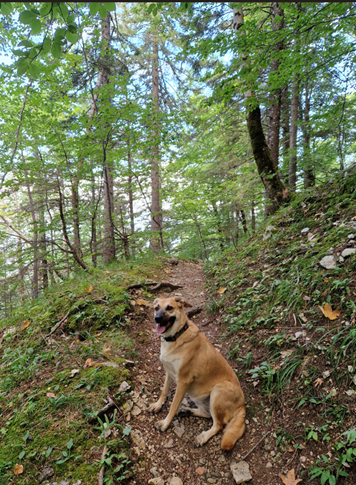
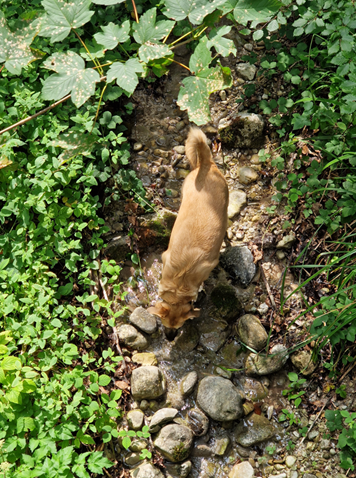
Why the Right Gear Matters
I’ve done enough mountain trips to know non tested equipment works until it doesn’t. When it fails, it fails at the worst possible moment — tent poles breaking in wind, backpack straps tearing mid-descent, headlamps dying when you need them most.
The hiking backpack distributed 15+ kilograms across two days of vertical terrain without creating pressure points or fatigue. Good suspension isn’t marketing — it’s biomechanics.
The tent set up quickly at 1,684 meters as daylight faded, withstood overnight wind, and packed down efficiently for the next day’s summit push. Shelter is non-negotiable in the mountains.
The headlamp provided reliable, hands-free illumination for camp tasks, safety, and early morning prep. Trying to hold a flashlight while cooking at altitude isn’t just inconvenient — it’s dangerous.
👉 Want to a good kit to start your trekking adventure:
Or a better waterproof one for big players ;) -> https://therightpace.store/products/camping-tent-for-1-or-2-or-3-persons-with-3000mm-or-4000mm-waterproof
https://therightpace.store/products/90l-waterproof-hiking-camping-backpack
Final Thoughts: Mountains, Dogs, and Gear That Works
My dog and I descended back to Saint-Laurent-du-Pont as the day warmed. He trotted beside me with the contented exhaustion of a dog who’s done real work, and I felt the particular satisfaction that comes from carrying everything you need into the mountains and bringing it all back down.
Modern technology quantifies what used to be pure experience — my watch captured every heart beat, every meter of elevation, every calorie burned. But data can’t capture everything.
The numbers say we hiked 25 kilometers, climbed 1,641 meters, and spent two days doing it. The experience is amazing, really cleaning mind up. Good gear transforms from luxury into necessity, and a reliable hiking companion — whether human or canine — makes all the difference.
That’s what makes you come back. That’s what makes you invest in equipment that works. And that’s what makes you eager to plan the next bivouac.
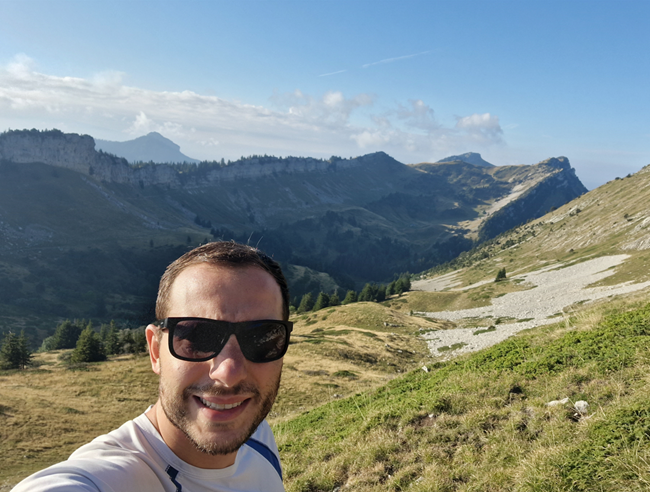
👉 Have you done this trekking or other amazing ones, please share your comments with us!
👉 Want the GPX? Let me know in the comments.
